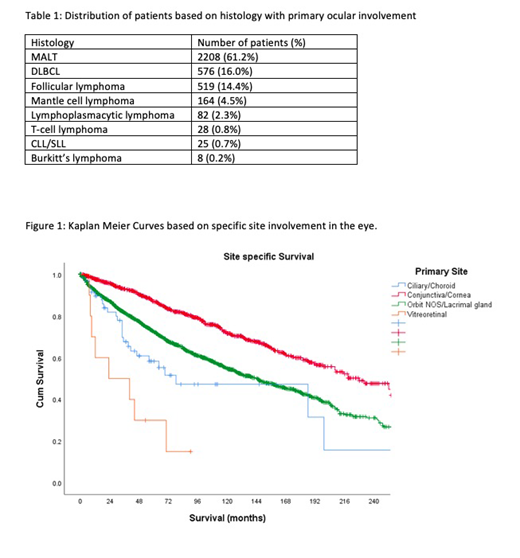BACKGROUND:
Malignant lymphomatous involvement of the eye and its surrounding structures is a rare phenomenon. Due to the unique location, non-specific symptomatology, limitations for invasive procedures, physician experience, and significant effect on the quality of life related to vision, it poses many challenges in the diagnosis and management. Ocular involvement can be primary or secondary in lymphoma. Primary ocular lymphoma, based on its clinical and pathological characteristics, has been divided into 2 main groups: those involving the orbit and adnexal tissues including lacrimal gland, conjunctiva and cornea and, those affecting intra-ocular structures mainly vitreous and retina. We aim to evaluate the SEER database to assess patterns and outcomes in patients with primary ocular involvement with lymphoma.
METHODS:
The Surveillance, Epidemiology, and End Results (SEER) database was used to identify patients (≥18 years) diagnosed with primary ocular lymphomas between 1975 and 2016. B-cell and T-cell lymphomas with stage I disease and primary site labeled as ocular (orbital, retina, conjunctiva, cornea, choroid, ciliary, lacrimal gland) were included. Treatment effect (surgery, radiation, systemic therapy) was analyzed when available.Overall survival (OS) was estimated using the Kaplan-Meier method and compared using the Log-Rank test. Cox proportional hazards models were used for adjusted survival analyses.
RESULTS:
We identified 3610 patients with primary lymphoma of the eye and adnexa. The median age was 66 years (18-103). 70% of the patients were Caucasians, followed by Hispanic (10%). Slight female preponderance was noted (55%). Most common site of involvement was orbit (n = 2063; 57%) followed by conjunctiva (n = 986; 27.3%). 8% (n = 292) of the patients were noted to have bilateral involvement. MALT (n = 2208; 61.2%) was the most common histology followed by DLBCL (n = 576; 16%) and follicular lymphoma (n = 519; 14.4%). Other histologies were rare (see Table 1). Most common treatment modality was radiation (n = 2117; 58.6%). Systemic therapy was utilized in only about 25% of the patients. Radiation treatment was associated with improved survival HR = 0.44 (0.23-0.83 95%CI, p = 0.01). Interestingly, patients that received systemic therapy had worse survival in univariate analysis (p<0.05) but was not significant in multivariate analysis. Site-specific survival suggested conjunctiva had the best median OS (19 years [16.3 - 21.7 95% CI]), followed by orbital and lacrimal gland involvement (median OS 12 years [10.92-13.23 95% CI]) - Figure 1. Retina (median OS 1.9 years) and choroid/ ciliary body (median OS 6.3 years) involvement were associated with shorter survival (p<0.05).
DISCUSSION:
Ocular lymphoma is a rare occurrence. Overall MALT was the most common subtype followed by DLBCL and FL. Very few instances of Burkitt's lymphoma, T-cell, and CLL were identified. Site-specific data in our subset, albeit with low numbers, suggest worse survival in the ciliary body and choroid similar to what is seen within vitreoretinal involvement. Due to small numbers in our subset, this requires confirmation in a larger dataset to identify potential change in management similar to primary vitreoretinal lymphoma, which is now recognized and managed as primary CNS lymphoma. Patients receiving systemic therapy showed a trend towards worse survival, which may be explained by a selection bias for more aggressive disease. Our study highlights the small but relevant prevalence of primary ocular lymphomas and reports the interesting observation of different survival patterns based on the site of involvement.
Yazbeck:Celgene: Membership on an entity's Board of Directors or advisory committees; Gilead Sciences: Research Funding; Seattle Genetics: Membership on an entity's Board of Directors or advisory committees.
Author notes
Asterisk with author names denotes non-ASH members.


This feature is available to Subscribers Only
Sign In or Create an Account Close Modal